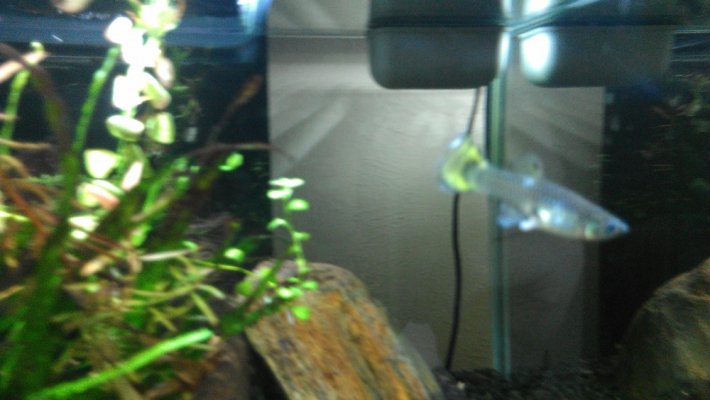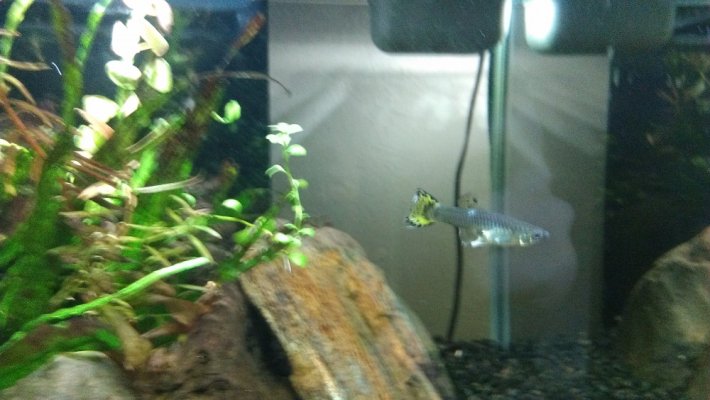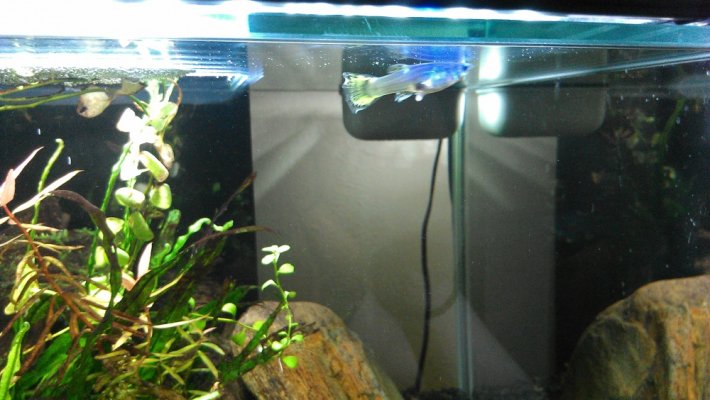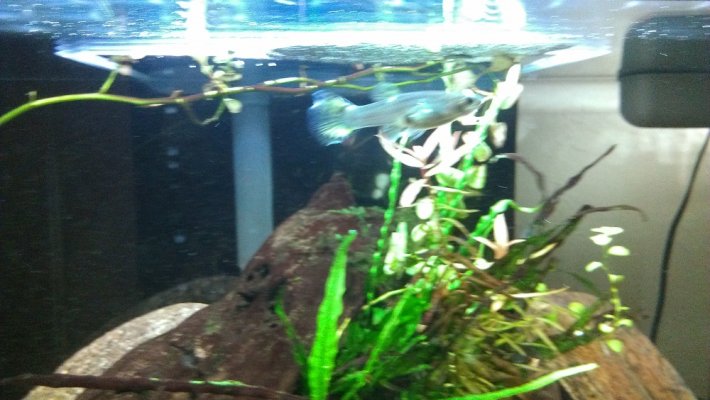kitten8351
Aquarium Advice Apprentice
Hi, I'm having troubles with an illness that started in one of my tanks, but has now spread to another (I'm assuming it did). I believe I may have started this whole mess when I was trying to treat for something else. Let me give you my set-ups and then I'll tell you a story.
Tank #1:
10 gallons
Gravel substrate
Penguin Biowheel 100 filter
bubble wall
unheated for summer, stays at 80 degrees F
3 big amazon sword plants
2 Amano Shrimp
?? guppies (was definitely overstocked, but not anymore)
Tank #2:
14-15 gallons
Sand substrate
Penguin Biowheel 100 filter
limewood air diffuser
unheated for summer, stays at 80 degrees F
1 piece of driftwood
3 big Amazon Sword plants
1 Limnophila
2 bunches of Ammania Praetermissa (Red Nesaea)
Several Java ferns
1 bunch of Alternathera Reineckii
3 Amano Shrimp
1 Panda Garra
?? Guppies (overstocked, 90% juveniles and fry)
Please note: I haven't had any issues with water quality due to these tanks being overstocked. I keep a closer eye on parameters because of this and perform more frequent water changes. I also take guppies I don't want/need to a local store as trade-in for store credit about every month or two. So please no chastising for overcrowding. I know, okay? I know.
This all started out about 2 weeks ago when I wanted to treat Tank #1 for their stringy, whitish poop. I did a ton of research, and based on information from various forums and articles, I got Metronidazole and started treatment. I put it in their water and also made it mixed with food. Things were fine up until about a day after the second dose. At that point most everyone started clamping and stopped swimming around. I stopped giving the Metronidazole food at the first sign of clamping. I figured that since they had already gone through the 2 doses now I could stop and it'd be fine. I thought I'd just need to wait out their discomfort, give them the best water, try to keep them happy and they'd recover. But then they started dying, oldest first. That got me thinking, "Oh no, what if I accidentally overdosed their food?!", but the Seachem bottle says Metronidazole is hard to overdose. Either way this problem wasn't going away.
Then the fin rot came. On many fish their pectoral fins were getting milky and starting to disintegrate. Some got tail rot as well, but it wasn't as aggressive as the fin rot. Their fins started looking like stringy puffy clouds, for a while I thought there was some sort of white growth on the fins, but I think I see now that it's their fins that are just whitish. In addition to the fin rot, some fish were showing a greyish/whitish film on spots of their body. It didn't appear to be extra fish slime, but maybe it is and it's just presenting weirdly. I can't tell if it's columnaris or not, but no one has had anything weird going on with their head/mouth if that helps.
As far as trying to combat this, whatever THIS is, I've been dosing Kanaplex (Kanamycin) and will be putting in the third dose tonight. I've done occasional 30min Methylene Blue baths in a bowl outside the tank for remaining fish. I added 1.5 Tbsp salt over a few hours yesterday. I don't know what more to do, the fish don't really look better yet, but not exactly worse either. I've lost probably 70% of the fish in there already. There are only like 5 fish left in there that went through the Metronidazole treatment, and 4 of those look bad. I expect that only 2 or 3 fish that went through the Metronidazole treatment to survive all of this. I did add 3 fish after being done with Metronidazole and before everyone clamped up. They are still find and dandy, no fin rot or any issues.
Now somehow as of 3 days ago, Tank #2 is now all clamped up near the surface. I took out about 5 dead fish the day they clamped up. I noticed my limewood air diffuser had this grey fuzzy crud on it (looked like mold), and thinking it had something to do with this issue, I took it out and replaced with a new one. I did a 25% water change at that time. Next day, fish were swimming lower down, but still clamped. I did a 40% water change last night and added 1.5 Tbsp salt, as now some fish are showing fin and tail rot, and it's moving fast. Several fish have died even without showing symptoms, others are dying because the fin rot is moving so quickly. It's only been 3 days! I have to assume that the fin rot in Tank #1 got into Tank #2, even though I rinse everything between tanks. Tonight I was planning on dosing Kanaplex into Tank #2 when I dose Tank #1 for the third time.
Is this the right course to take? What else can I do? This is my fault and I have to do whatever I can to fix it! Tank parameters below.
Meds at my disposal:
Salt
Methylene Blue
Jungle Fungus Clear
API General Cure (used this in both tanks several months ago for gill flukes)
Kanaplex
Metronidazole
Tank #1:
10 gallons
Gravel substrate
Penguin Biowheel 100 filter
bubble wall
unheated for summer, stays at 80 degrees F
3 big amazon sword plants
2 Amano Shrimp
?? guppies (was definitely overstocked, but not anymore)
Tank #2:
14-15 gallons
Sand substrate
Penguin Biowheel 100 filter
limewood air diffuser
unheated for summer, stays at 80 degrees F
1 piece of driftwood
3 big Amazon Sword plants
1 Limnophila
2 bunches of Ammania Praetermissa (Red Nesaea)
Several Java ferns
1 bunch of Alternathera Reineckii
3 Amano Shrimp
1 Panda Garra
?? Guppies (overstocked, 90% juveniles and fry)
Please note: I haven't had any issues with water quality due to these tanks being overstocked. I keep a closer eye on parameters because of this and perform more frequent water changes. I also take guppies I don't want/need to a local store as trade-in for store credit about every month or two. So please no chastising for overcrowding. I know, okay? I know.
This all started out about 2 weeks ago when I wanted to treat Tank #1 for their stringy, whitish poop. I did a ton of research, and based on information from various forums and articles, I got Metronidazole and started treatment. I put it in their water and also made it mixed with food. Things were fine up until about a day after the second dose. At that point most everyone started clamping and stopped swimming around. I stopped giving the Metronidazole food at the first sign of clamping. I figured that since they had already gone through the 2 doses now I could stop and it'd be fine. I thought I'd just need to wait out their discomfort, give them the best water, try to keep them happy and they'd recover. But then they started dying, oldest first. That got me thinking, "Oh no, what if I accidentally overdosed their food?!", but the Seachem bottle says Metronidazole is hard to overdose. Either way this problem wasn't going away.
Then the fin rot came. On many fish their pectoral fins were getting milky and starting to disintegrate. Some got tail rot as well, but it wasn't as aggressive as the fin rot. Their fins started looking like stringy puffy clouds, for a while I thought there was some sort of white growth on the fins, but I think I see now that it's their fins that are just whitish. In addition to the fin rot, some fish were showing a greyish/whitish film on spots of their body. It didn't appear to be extra fish slime, but maybe it is and it's just presenting weirdly. I can't tell if it's columnaris or not, but no one has had anything weird going on with their head/mouth if that helps.
As far as trying to combat this, whatever THIS is, I've been dosing Kanaplex (Kanamycin) and will be putting in the third dose tonight. I've done occasional 30min Methylene Blue baths in a bowl outside the tank for remaining fish. I added 1.5 Tbsp salt over a few hours yesterday. I don't know what more to do, the fish don't really look better yet, but not exactly worse either. I've lost probably 70% of the fish in there already. There are only like 5 fish left in there that went through the Metronidazole treatment, and 4 of those look bad. I expect that only 2 or 3 fish that went through the Metronidazole treatment to survive all of this. I did add 3 fish after being done with Metronidazole and before everyone clamped up. They are still find and dandy, no fin rot or any issues.
Now somehow as of 3 days ago, Tank #2 is now all clamped up near the surface. I took out about 5 dead fish the day they clamped up. I noticed my limewood air diffuser had this grey fuzzy crud on it (looked like mold), and thinking it had something to do with this issue, I took it out and replaced with a new one. I did a 25% water change at that time. Next day, fish were swimming lower down, but still clamped. I did a 40% water change last night and added 1.5 Tbsp salt, as now some fish are showing fin and tail rot, and it's moving fast. Several fish have died even without showing symptoms, others are dying because the fin rot is moving so quickly. It's only been 3 days! I have to assume that the fin rot in Tank #1 got into Tank #2, even though I rinse everything between tanks. Tonight I was planning on dosing Kanaplex into Tank #2 when I dose Tank #1 for the third time.
Is this the right course to take? What else can I do? This is my fault and I have to do whatever I can to fix it! Tank parameters below.
Meds at my disposal:
Salt
Methylene Blue
Jungle Fungus Clear
API General Cure (used this in both tanks several months ago for gill flukes)
Kanaplex
Metronidazole




